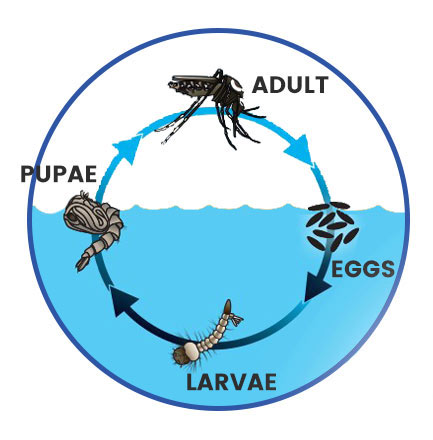Mosquito Species of SWFL
Mosquitoes by the Numbers
ST LOUIS ENCEPHALITIS
WEST NILE VIRUS
DENGUE FEVER
YELLOW FEVER
CHIKUNGUNYA
MALARIA
ZIKA
Fight the Bite!
FREE Mosquitofish
for standing water
Fight the Bite!
Mosquitoes by the Numbers
ST LOUIS ENCEPHALITIS
WEST NILE VIRUS
DENGUE FEVER
YELLOW FEVER
CHIKUNGUNYA
MALARIA
ZIKA
Mosquito Life Cycle
Female mosquitoes need to obtain a blood meal before they can produce eggs. After she enjoys some blood, she lays her eggs either on the surface of stagnant water or near water where the eggs will eventually be flooded. The eggs hatch in the water and wiggly mosquito larvae emerges. The larvae live in the water, feed on microscopic organisms, and develop into pupae. The pupae also live in the water, but no longer eat anything. Finally, a mosquito emerges from the pupa on the surface of the water as a fully developed adult, and the cycle again begins.
Year-round Mosquito Testing

Mosquito Species We Closely Monitor
ANOPHELES
Appearance:
The body of the adult Anopheles mosquito ranges from dark brown to black. When resting, the stomach area of the Anopheles mosquito species points upward, rather than being even with the surrounding surface like most other mosquitoes.
Behavior:
Anopheles hang out in the lower levels of thick plants and especially tall grasses. They are active during the evening and night hours. They are referred to as “leg” or “ankle” biters because of their low-flying preference. These mosquitoes don’t like the hot, dry sun and prefer the higher humidity at night.
The female Anopheles mosquito will mate several times in her short life span, producing eggs after she has found a blood meal. Although she only lives a few weeks to a month, she will have been able to produce thousands of eggs during that time.
CULEX QUINQUEFASCIATUS
Appearance:
Culex quinquefasciatus is a light brown mosquito with faint white bands on its proboscis and abdomen.
Behavior:
Both male and female Culex feed on nectar and plant fluids. When the female is ready to lay eggs, she then feeds on the blood of both birds and mammals from dusk to dawn.
The female Culex is most active during the few hours after sunset. They prefer lying in wait for their hosts in the thick leafy areas of trees where birds nest and roost. They can also be found in tree trunks and animal dens.
CULEX NIGRIPALPUS
Appearance:
Culex nigripalpus is a medium-size brown mosquito with a dark proboscis and very few if any other coloring differences. Dark brown or black scales cover the abdomen and legs, which often appear to have a bronze or metallic blue-green reflection.
Behavior:
This mosquito is most commonly found during the wet summer months, and females prefer to lay their eggs in freshly flooded ditches. The females obtain blood meals from hosts ranging from tree frogs to humans.
AEDES AEGYPTI & AEDES ALBOPICTUS
Appearance:
Aedes albopictus mosquitoes are visually distinct because they have black and white stripe markings on their bodies and legs, with a white stripe down the middle of their thorax. Aedes aegypti resemble its cousin in most aspects, except it has a lyre-shaped mark on its thorax.
Behavior:
Both species are active during the day in shaded areas and into the early evening, but they will sometimes bite after dark. Females blood-feed primarily on humans in order to produce eggs. An infected female Aedes acquires a virus by feeding on the blood of an infected person, then passes the virus to other humans through her bite.
MANSONIA
Appearance:
The Mansonia mosquitoes are large black or brown insects with sparkling wings and legs, and their abdomens are very broad. They are often described as having a “salt-and-pepper” appearance.
Behavior:
The Mansonia’s larvae are different from other mosquitoes because they are able to attach to aquatic plants below the water surface, piercing the stalk to obtain oxygen. Other mosquito larvae typically “breathe” at the water surface. In Southwest Florida, the Mansonia prefer plants such as the water hyacinth and water lettuce.
AEDES TAENIORHYNCHUS
Appearance:
Aedes taeniorhynchus mosquitoes are small to medium in size, dark brown with white bands around their abdomen, and white stripes on their legs. Unlike the Aedes aegypti, there are no markings on their back.
Behavior:
The Black Salt Marsh Mosquito is considered a major pest in coastal Florida and has the unique characteristic of emerging in very large numbers all at once in a cloud or “brood” of mosquitoes. These migratory insects breed in salt marshes and mangroves, use prevailing winds to travel up to 40 miles. They are aggressive biters and feed on whatever is available, but they prefer mammals.



